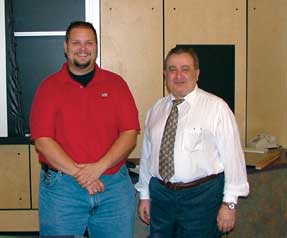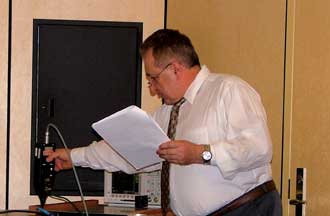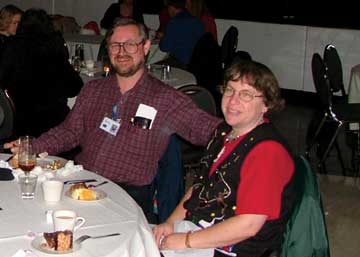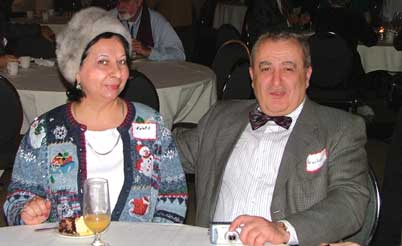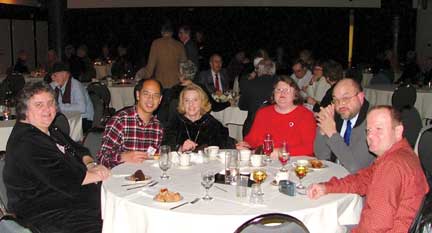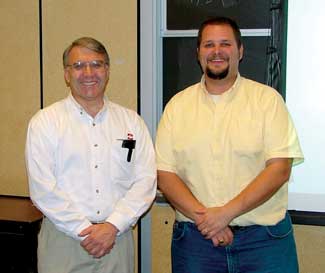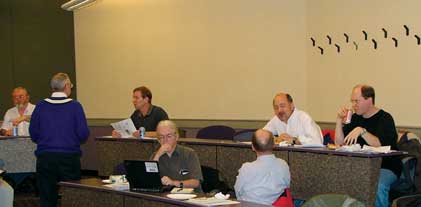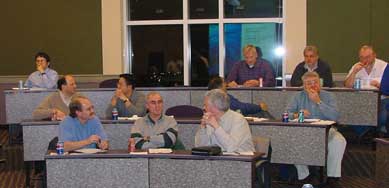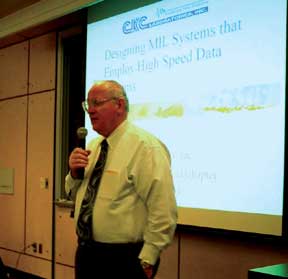EMC Guru and longtime
IEEE EMC Society member Ron Brewer shared this classic “EMC
War Story” with Chapter Chatter. When you read this,
I am sure you will really feel sorry for Ron . . . what a
rough assignment!
A Really Short ‘Vacation’ in the Bahamas
Once upon a time, when the Bahamas telephone toll center transactions
were only $175,000 US per day — and EMC engineers made
a great deal less — our facilities safety manager was
attending to his appointed rounds with his brand-new, brand-name
RF field intensity meter in hand. He wanted to make sure that
the electric fields within the facility were less than the
allowed maximum of 10mw/sqcm (194V/m). After all, our company
didn’t want to accidentally cook anyone that worked there.
It wouldn’t look good come time to renew their management
contract.
Much to the safety manager’s surprise, the fields being
generated by the video display units (VDU) at the operator
consoles were way above the maximums. A quick calculation
disclosed that the measured field intensities were in excess
of 300 V/m! Did he call anyone? Did he ask how was that possible?
Of course not! Being a good safetyman, with genuine concern
for the workforce, he immediately shut down the toll center.
Then, he called to report his findings. Then, his boss called
corporate headquarters and they called my boss and also those
of the six other EMC facilities that we had scattered around
the world. Then seven EMC engineers, myself included, immediately
reported to the Bahamas to solve this serious problem. At
$175,000 per day there was a lot of incentive to get there
quickly.
We were prompt, but still didn’t all arrive at the same
time. But when we did, we found that the first EMC engineer
on the scene had already discovered that the brand-new, brand
name RF field intensity meter was susceptible to the 15 kHz
VDU raster sweep frequency, and the toll center was back on-line.
Of course, this required an appropriate celebration at a little
place nearby . . . but that’s a different story! |
Atlanta
After several years of not holding a meeting, the Atlanta Chapter
convened on Monday, October 13 for a one-day tutorial and exhibition
with Clayton Paul of Mercer University. Dr. Paul gave his popular
presentation titled, “The Fundamentals of EMC.” Over
65 people participated in this event and there were 13 exhibitors
staffing tabletop displays. It was a very successful event! The
Chapter was approached to hold this tutorial and exhibition shortly
after the August IEEE EMC Symposium in Boston, Massachusetts.
Dr. Paul in nearby Macon County had a day free during the university
break and offered to speak at the Chapter. The Chapter was reluctant
to commit to such a big name speaker; after all, since they had
not held a formal meeting in years, would anybody come? One would
not want to disappoint Dr. Paul! Chapter Chair Janet Luo rallied
her support team of long time EMC colleagues from the Georgia
Tech Research Institute, including Don Clark, past president of
the EMC Society, Hugh Denny, long time member of the EMCS Standards
Committee, and Dave Millard, past member of the EMCS Board of
Directors. Scott Proffitt of Advanced Compliance Solutions, a
test laboratory in Buford, Georgia that does EMC, product safety,
and environmental testing, initiated an e-mail and web blitz.
As a result, it was determined that there was enough interest
to ensure a good turnout for Dr. Paul. Thus, the event was a go
and Janet Luo worked overtime to process registrations, purchase
raffle prizes, handle the finances, etc. etc. During the event,
several attendees convened and determined that the chapter needed
to hold regular meetings again in Atlanta. Scott Proffitt volunteered
to organize this effort until the chapter officers could be formally
elected. Also, a NEW chapter was discussed for the nearby Huntsville,
Georgia area. Rodney Boyd of WEMS Electronics and Jack Black of
DLS Electronic Systems were instrumental in spearheading this
discussion. The exhibitors volunteered to support these chapter
efforts by providing speakers upon request. It was a productive
day of networking and an excellent jump-start for the Atlanta
EMC Chapter to get active again!
 |
| Clayton Paul and Janet O’Neil
celebrate the publication of Dr. Paul’s newest book,
“Electromagnetics for Engineers.” |
 |
| Joining in the book celebration in
Atlanta are (clockwise from left) Scott Proffitt of Advanced
Compliance Solutions, Dr. Paul, Janet O’Neil, Edith Clark,
Don Clark, Hugh Denny, Margie Denny, Janet Luo and Don Brown.
|
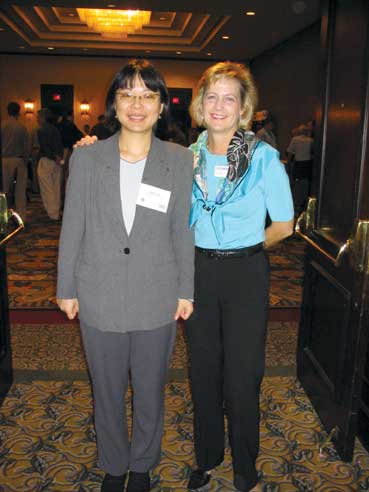 |
| The “Two Janets” that organized
the Atlanta EMC Chapter’s Tutorial and Exhibition with
Clayton Paul: Janet Luo (left) of Capraro Technologies and
Janet O’Neil of ETS-Lindgren. |
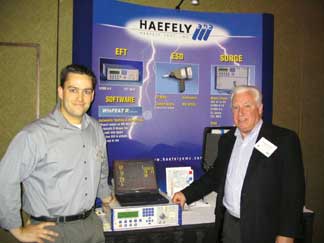 |
| Chris Faust of Haefely EMC (left)
was joined by Dennis McGlinsey of W. A. Brown Instruments
at the Atlanta EMC event. |
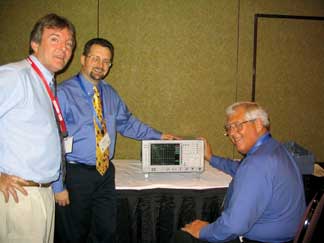 |
| Mike Hardiman and Don Brown of Brennan
Associates witnessed a product demonstration by Dortch Walker
(from left) of Rohde & Schwarz during the Atlanta exhibition. |
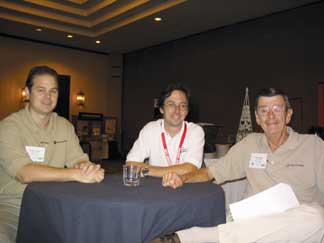 |
| Exhibitor break time during the Atlanta
EMC event allowed John Fisher of Test Equipment Corporation
(center) to visit with Rodney Boyd (left) and David Stanis
of WEMS Electronics. |
 |
| It’s not everyday an EMC event
falls on your birthday! The Atlanta EMC Chapter recognized
Chris Faust’s (right) birthday on October 13. Eyeing
that delicious dessert are Rodger Gensel (left) and John Whitney
of Amplifier Research. |
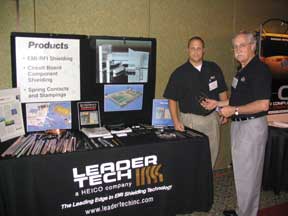 |
| Leader Tech participated in the exhibition
held during the Atlanta EMC Chapter tutorial with Clayton
Paul. Joel Sparr (left) and Darrell Yarbrough were present
to man their display. |
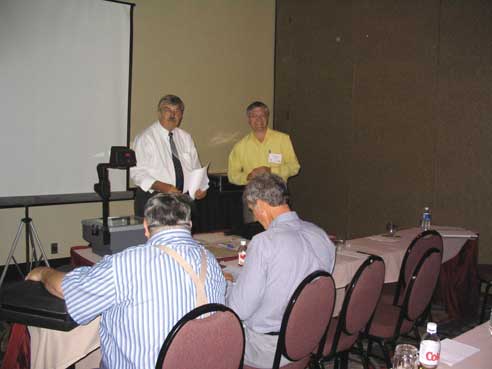 |
| Stephen Embry of EMS Technologies
(right) is shown with speaker Dr. Paul following the conclusion
of his tutorial on “The Fundamentals of EMC.” |
Beijing
The 3rd Asia-Pacific Conference on Environmental Electromagnetics
(CEEM 2003) was held on November 4 to 7 in Hangzhou, China. Gao
Yougang, Chairman of the Beijing EMC Chapter, and General Chairman
of CEEM 2003, provided a report on the conference by Dr. Li Shufang.
Dr. Shufang advised that this conference is held every three years
in China. The emphasis this year was on effects to the human body
and brain which is not surprising given that people now live in
an ocean of various kinds of electromagnetic waves with wavelengths
from nanometers to thousands of kilometers, which may be active
or negative and need to be tested and well used. Some 200 papers
were submitted of which 152 were accepted. The papers reported
on the rapid progress over the past three years in both research
of environmental electromagnetics and new EMC technology. Scholars
and experts from all over the world attended the conference. There
were four keynote speeches presented by experts in their respective
fields, including: “Ionospheric Perturbation Associated with
Earthquakes, as Revealed from Subinonospheric VLF/LF Propagation”
by Masashi Hayakawa from Tokyo, Japan; “Some Effective Methods
in Computational Electromagnetics” by D. G. Fang from Nanjing,
China; “Properties of a Field-reduced Twisted Three-phase
Power Cable of Finite Length” by Mathias Enrich from Hamburg,
Germany; and, “A Generalized Algorithm for Antenna Near-field
Computation in EMC Prediction” by Gao Ben-qing from Beijing,
China. The next CEEM 2006 will be held in Dalian, China.
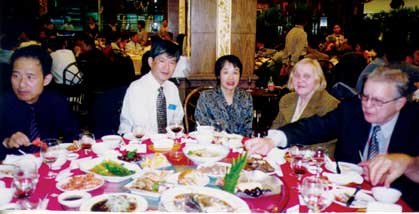 |
| Professor Yang Qianli, Professor
Ryuji Koga, Mrs. Koga, Mrs. Sokolov, and Professor S. A. Sokolov
(from left) enjoy the conference banquet held during CEEM
2003. |
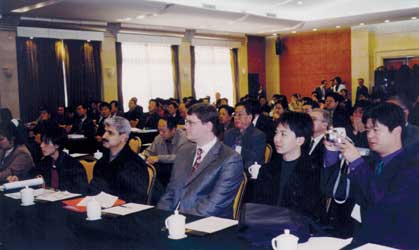 |
| The keynote speeches attracted a
large audience during CEEM 2003. |
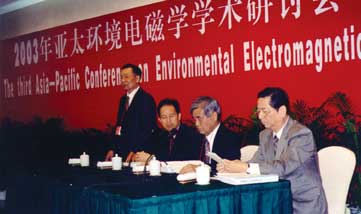 |
| Professor Gao Yougang (standing)
made a short speech during the opening ceremony for CEEM 2003.
Joining him at the head table are Professor Yang Qianli, Professor
Shuichi Nitta, and Professor Massashi (seated from left). |
Central New England
John Clarke, Chapter Co-Chair, reports that a joint meeting with
the Northeast Product Safety Society (NPSS) was held on Wednesday
October 22, 2003. The speaker was EMC Society Distinguished Lecturer
Dr. Cheung-Wei Lam, Senior Engineer at Apple Computer, Inc. in
Cupertino, California. The topic presented was “ Signal Integrity
Design versus Radiated Emission Control.” Dr. Lam is engaged
in IC, PC board and system level EMC R&D at Apple Computer
and has implemented an EMC design and analysis process to facilitate
on-time design at lower cost. Dr. Lam presented trade-offs and
guidelines for signal integrity design versus radiated emission
control. As a benefit to engineers responsible for both disciplines,
an in-depth understanding of the similarities and differences
between the two is very important. In his presentation, key signal
integrity and EMC concepts were reviewed. Design considerations
in the two disciplines were compared and contrasted at the chip
and PCB levels. Prior to joining Apple, Dr. Lam was a co-founder
and Principal Engineer of Transcendent Design Technology and he
worked in Viewlogic’s Development Group (formerly Quad Design
Technology). Over the years, he has played key roles in the design
and development of EMC, signal integrity and ground bounce analysis
software tools. 36 people attended the October meeting, of which
14 were IEEE EMCS members and 22 were NPSS members or guests.
(Some IEEE members are also NPSS members). The Central New England
chapter expects to have its next meeting in March 2004. Also,
Distinguished Lecturer Professor Michel Ianoz was scheduled December
22 to present his topic “Lightning Electromagnetic Effects,”
but due to his illness this is being scheduled for a new date
in 2004.
Chicago
In October, the Chicago Chapter held a joint meeting with the
local SAE, IEST and ASME chapters. Elite Electronic Engineering
hosted the meeting. All in attendance enjoyed the great German
food and polka music in keeping with the October Fest theme. A
Cubs playoff game on the “big screen” was also a hit!
The interaction between the different groups was well received.
The chapter also held its annual Holiday social in December. Everyone
had a good time. Approximately 60 people attended this event held
again at Dave & Busters for the second year. Hats off to Carla
Robinson for coordinating this effort, and to Jack Black, the
new Chapter Chair, for coordinating the pool tournament. Thanks
too to Dwayne Davis for providing the fun balloons.
The pictures say it all!
 |
| A tour of Elite Electronic Engineering
was held prior to the October Chicago Chapter meeting. |
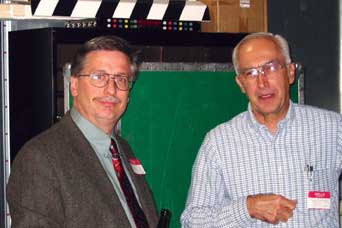 |
| Tom Braxton (left) and Roger Swanberg
of DLS Electronic Systems visited prior to the October meeting
of the Chicago Chapter. |
 |
| Dwayne Davis of Associated Research
(left) contributed to the fun of the Chicago Chapter Holiday
social by making a special balloon for Brandon Krozel. |
 |
| Ida Krozel enjoyed her balloon sculptures,
courtesy of the Chicago Chapter. |
 |
| Tom Braxton of Braxton EMC, Frank
Krozel of Electronic Instrument Associates Central, Inc.,
Craig Dinsmore of Elite Electronic Engineering, and Nick Karnezos
(from left) all enjoyed the Chicago Chapter Holiday social
event in December. |
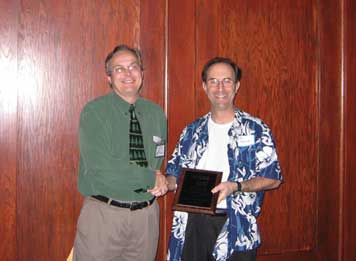 |
| Ray Klouda of Elite Electronic Engineering
(left) congratulates Jerry Meyerhoff of Motorola. Jerry was
recognized as “Person of the Year” by the Chicago
Chapter. |
 |
| Wolf Josenhans of US Robotics (left)
pauses to evaluate his next pool shot under the watchful gaze
of Dwayne Davis of Associated Research (far right). The pool
tournament was a big hit at the Chicago Chapter Holiday social. |
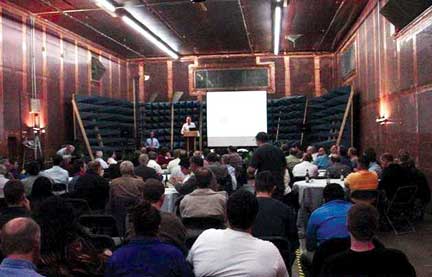 |
| A full house was present at the October
Chicago Chapter meeting to hear Bob Hofmann speak. |
Israel
Moshe Z. Netzer, the Israel EMC Chapter Chairman, reports that
they cooperated with the Holon Academic Institute of Technology
(HAIT) to organize a one-day meeting. This meeting involved the
EMC Chapter along with four other professional IEEE Chapters in
Israel: Communication, Antenna and Microwave (MTT/AP) Vehicular
Technologies (VT) and Electronic Devices (ED). The title of the
meeting was: “Electromagnetic Radiation Aspects: Applications
in Communication Engineering, EMC, Antenna and Microwave, and
Electronic Devices.” About 95 engineers and 130 students
from HAIT attended the meeting. The feedback was simply great!
The morning session, in which all the attendees had gathered,
was devoted to “Electromagnetic Radiation Aspects.”
During the afternoon, there were three different sessions on EMC,
Communications, and Electronic Devices. The morning session was
opened with speeches from HAIT president, Professor David Mohalem
Maron, Professor Jacob Gavan, the Dean of HAIT School of Electrical,
Electronic and Communication Engineering, Professor Gadi Golan
Head of HAIT Electrical and Electronic Faculty, Mr. Elya Joffe,
EMCS BoD member and Region 8 Coordinator, and Mr. Moshe Netzer,
Israel IEEE EMC Chapter Chairman. Mr. Joffe called to the stage
several EMC engineers who received appreciation certificates from
IEEE for outstanding professional achievements. He then detailed
and described the upcoming 2004 EMC Symposia, worldwide. The morning
session included very interesting lectures on Electromagnetic
Radiation Aspects. These papers included:
-
Dr. Stelian Gelberg, from the Ministry of
Environment presented, “Determining an Exposure Threshold
for Electromagnetic Radiation.”
-
Mr. Moshe Netzer, Israel IEEE EMC Chapter
Chairmen gave a paper entitled, “International Exposure
Standard of ELF Magnetic and Electric Fields and Proven Biological
Effects.”
-
Mr. Oren Hartal, RAFAEL Chief Scientist,
presented, “Engineering Consequences of Coping with ELF
10 mG Exposure Threshold.”
-
Professor Jacob Gavan, Dean of HAIT School
of Electrical, Electronic and Communication Engineering, presented,
“Techniques for Increasing Radiated Power Efficiency and
Reducing Undesired Parasitic Radiation, Particularly in Cellular
Systems.”
The afternoon had three parallel sessions including:
EMC, Communications and Electronic Devices. Following are some
of the many subjects presented in these sessions:
-
EMC Session: Mr. Elya Joffe, “Path of
Least Inductance as a the Base Principal for Fast Digital PC
Board Design”; Dr. Alex Axelrod, “Impact of Balancing
on EMC System Performance”; Mr. Ilan Cohen, “Safety
Vs EMC: Product Design Consideration.”
-
Communications Session: Dr. Jacob Baal-Shem,
“Consumer Communications and Networking”; Dr. Moshe
Ran, “Trends in Air Interfaces for 4G Mobile Communication
Systems”; Dr. Reoven Midan, “Spectrum Sharing and
Interference Issues Associated with Mobile Satellite Services
(MSS)”; Mr. Alan Bensky, “Telecom Authority Regulations:
Obstacle or Catalyzer to the Advancement of Wireless Communication”;
Dr. Haim Metzner, “A Novel Broad Band Double Short Wall
Printed Antenna.”
-
Electronic Devices: Professor Gadi Golan,
“Barium Titanate Enthalpy Sensors”; Dr. Alex Eksilevtz,
“Phase Transition Mechanism in Vanadium Oxide Thin Films”;
Dr. Igor Lepsker, “Distance Learning of Scanning Electron
Microscope”; Professor Michael Glob, “Applications
of Diffractive Optics.”
The admission to the meeting was free. The chapter is very grateful
for the five hundred dollars in “Angel Funds” from the
IEEE EMCS that supported the meeting.
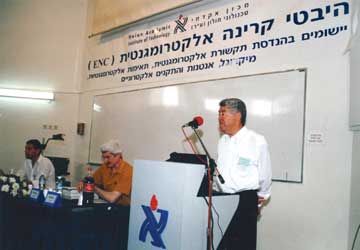 |
| Welcome address from Professor Jacob
Gavan at the Israel Chapter one-day meeting. |
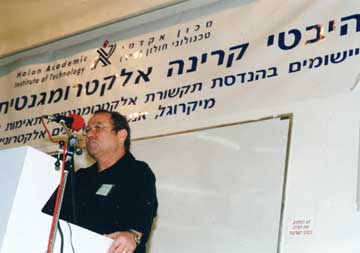 |
| Welcome address from Mr. Moshe Netzer,
Israel EMC Chapter Chairman. |
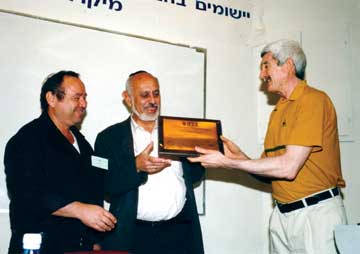 |
| Elya Joffe (right) and Moshe Netzer
present a Certificate of Technical Achievement to Benjamin
Vitorio Kauders (center). |
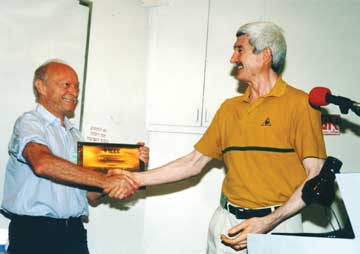 |
| Elya Joffe presents a Certificate
of Technical Achievement to Oren Hartal. |
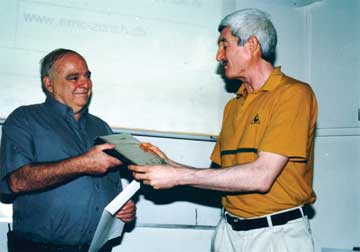 |
| Elya Joffe presents a Certificate
of Technical Achievement to Armon Rabiah. |
Korea
Jong-Hwa Kwon, the secretary of the Korea EMC Chapter and Professor
Dong Il Kim (Korea Maritime University), Chairperson of the Korea
EMC Chapter, report that the Korea Chapter hosted the “2003
EMC Korea Workshop” at the Seoul Education Center on October
16. The 11 presentations covered various aspects of EMI/EMC measurement,
numerical analysis, and signal integrity, among other EMC topics.
The workshop also included Mr. Mike Gleavese’s paper titled
“GTEM Systems Theory, Application and Quality”. The
workshop was attended by 100 participants and was coordinated
by the Korea Electromagnetic Engineering Society (KEES) and the
IEEE AP/MTT Korea Chapter.
Mohawk Valley
The Mohawk Valley Joint EMC/Reliability Chapter ended its activities
for 2003 on a high note in December by hosting guest speaker Dr.
John Norgard. Back by popular demand, Dr. Norgard gave an encore
presentation of his talk on “Thermal Images of Electromagnetic
Fields Using Infrared Thermography and Microwave Holography.”
Dr. Norgard summarized a novel technology that he has been applying
to measure electromagnetic energy using infrared techniques. He
extended his presentation on the related topic of Microwave Holography.
Several examples were presented of electric field distributions
radiated from microwave antennas and high power microwave (HPM)
sources, scattering from and diffraction around complicated metallic
objects, e.g. model aircraft, coupling through apertures in shielded
enclosures, and modal distributions excited inside waveguide cavities.
Examples of magnetic field distributions near conductive surfaces
and induced surface currents on metallic surfaces were also presented.
The advantages and disadvantages of this new IR measurement technique
were discussed. In summary, the technique involves placing a minimally
perturbing (thin, planar, low-loss) IR detection screen in the
plane over which the EM field is to be measured. The temperature
rise in the screen, due to Joule heating of the lossy screen material,
is proportional to the intensity of the incident field and creates
a 2D thermal map (IR thermo gram) of the intensity of the EM energy
absorbed in the screen. The temperature distribution in the detector
screen is measured with a sensitive IR camera and is converted
into a false color image (3D relief map or 2D contour plot) of
the field, which produces a visual image of the field being measured.
Using the thermal and electrical parameters of the detector screen,
the magnitude of the electric or magnetic field that produced
the temperature rise in the screen can be measured on a pixel-by-pixel
basis. By creating an interference pattern (hologram) with a known
standard, e.g., a standard gain horn antenna (calibrated at NIST/Boulder),
or by using iterated plane-to-plane 2D Fourier Transforms (FFTs),
the phase of the electric or magnetic field can also be determined.
This research continues to be of much interest to the Air Force
Research Laboratory in Rome, New York. EMC Chapter Chair Irina
Kasperovich plans for future talks in 2004 that will address additional
interests of the local engineering and technical community. These
include topics on New Paradigms for Spectrum Management, Product
EMC Compliance, and Computational Electromagnetics.
Orange County
Chapter Chairman Robert Tozier reports that the Orange County
EMC Chapter had two meetings during the Fall. On October 23, they
held a “Vendor Show” with presentations from four leading
manufacturers of EMC solutions. On November 18, the Chapter presented
“An Overview of Accepted Test Methodologies for Determining
the EMC Compliance of Wireless Devices”. Many thanks to Northwest
EMC for hosting the meetings at their new facility in Irvine!
The “Vendor Show” featured Mike Nelson from Laird who
presented EMI/RFI Gasket Solutions, Jim Ott from TDK RF Solutions
who presented “Future Technologies in Test Chambers,”
Eran Israely from Ophir who gave a presentation regarding in-band
harmonics and, last, but not least, Vince Rodriguez from ETS-Lindgren
who presented “The EMCO 3117 Double Ridge Guide Horn”
which described the changes made to the traditional DRGH antennas
used in EMC to accomplish a single well defined main radiating
lobe. Each of the speakers had up to 20 minutes to present new
technologies and solutions from their respective companies. For
the November meeting, Greg Kimmel of Northwest EMC gave a presentation
on testing and certification of wireless devices. This was a learning
experience for many of the attendees. The technical presentation
was well received and many stayed afterwards to ask questions.
Both the October and November presentations had over 25 attendees
each and the Chapter officers are excited to see the attendance
continue to grow. The Orange County Chapter is looking forward
to a terrific 2004, especially with the improving economy. The
Orange County Chapter elections were also held in November. The
Chapter is pleased to announce that Sharish Shah from Compatible
Electronics was elected Vice-Chair. He will be joining Robert
Tozier from CKC Laboratories, Rick Candelas from Aegis Labs and
Ed Nakauchi from Laird in 2004. Randy Flinders, the former Chairman
and Vice-Chairman, elected to not run again. The Chapter is very
thankful for his many years of service to the Orange County Chapter.
Randy will continue to help with updating the Chapter Web-Site.
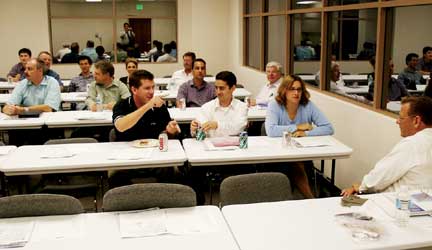 |
| The Orange County Chapter relaxes
and awaits the start of vendor presentations during the October
meeting at Northwest EMC. |
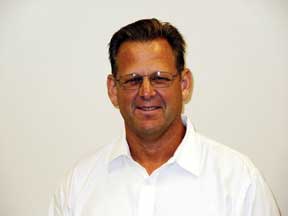 |
| Mike Nelson of Laird Technologies
also participated as a speaker in the Orange County Chapter
“Vendor Show.” |
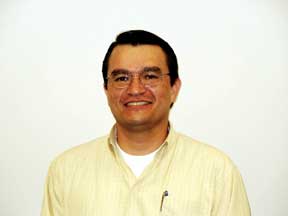 |
| Jim Ott of TDK RF Solutions presented
“Future Technologies in Test Chambers” at the Orange
County Chapter “Vendor Show.” |
 |
| Orange County meeting attendees enjoyed
a tour of the new Northwest EMC facility in Irvine following
the technical presentations. |
 |
| Eran Israely of Ophir RF participated
as a speaker at the Orange County Chapter “Vendor Show.” |
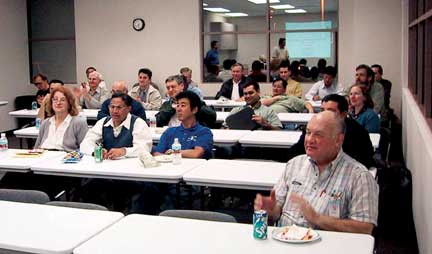 |
| The Orange County Chapter gets ready
for Greg Kiemel’s popular and informative transmitter
testing and certification talk. |
 |
| Greg Kiemel of Northwest EMC speaks
to a full house during the November Orange County Chapter
meeting at Northwest EMC. |
 |
| Vince Rodriguez of ETS-Lindgren spoke
about advances in antenna performance design at the Orange
County Chapter “Vendor Show.” |
Oregon and Southwest Washington
David Britton, the Chapter Vice Chair, reports that the Oregon
and SW Washington chapter held their first meeting of the Fall
season on September 29, 2003. After dinner, Distinguished Lecturer
Chris Kendall of CKC Laboratories presented, “Designing MIL
Systems that Employ High Speed Data Systems” to an enthusiastic
crowd. All enjoyed Chris’s presentation. In October, Varuzhan
Kocharyan from Northwest EMC, also the Chapter Membership Director,
presented his paper “Express Diagnostic Method for ESD Simulators
and ESD Test Stations”. He originally presented this paper
at the Boston Symposium. His presentation included a demonstration
of the method. Several attendees expressed interest in duplicating
the method in their labs. Franz Gisin of Sanmina-SC was the presenter
in November. Franz spoke on “Thinking Outside of the Trace:
The Physics of High Speed PCB and Backplane Interconnects”.
His high-resolution color simulations of field propagation wowed
the audience and garnered several questions. The chapter members
also enjoyed the annual Holiday Social at the Oregon Museum of
Science and Industry this year. The chapter joined the local IEEE
Section officers and the Electronic Representatives Association
at the party. Of the nearly 100 attendees, 22 were from the EMC
Chapter. The festively decorated local “Christmas Ships”
cruised by on the Willamette River just outside the windows of
the reception hall to the enjoyment of all. 2004 events planned
for the Oregon SW Washington Chapter include:
-
On January 20, the chapter will form a vanpool
for interested members and participate in the Seattle Chapter’s
Tutorial and Exhibition featuring Distinguished Lecturer Bruce
Archambeault and DL coordinator Lee Hill. This is an all day
excursion!
- On February 25, the chapter will participate in a one-day event
in Portland sponsored by Amplifier Research. William Parker of
Parker EMC will present a tutorial on “RF Immunity/Susceptibility
Testing”. Chuck Britten, our Chapter Secretary, coordinated
this event.
-
On March 24, William Owsley from Underwriters
Labs and our Chapter Treasurer will present to the chapter.
- On April 28, Distinguished Lecturer C.W. Lam from Apple Computer
will present to our chapter.
-
On May 19, William Parker of Parker EMC will return to our
chapter to present on a different subject.
Phoenix
Glen Gassaway reports that the Phoenix Chapter had another very
good turn out at its November 13 Chapter meeting, held at Garcia’s
Mexican Restaurant in Tempe. The social hour went long, as they
sat and ate their fill of Garcia’s wonderful food. Harry
Gaul brought the meeting to order at 7:15 pm. This time, the meeting’s
attendance included several manufacturers’ representatives
from the Valley as well as from other locations around the country.
Of course, the usual bunch of Valley EMC’ers was well represented.
During introductions, Bill Blanford brought up that Orbital Sciences
was looking for a permanent-hire EMI Engineer. Daryl Gerke then
got everyone’s attention and formally introduced the featured
speaker, Jim Muccioli, the Chief Technology Officer for X2Y Attenuators.
Jim was accompanied by Sypher-representative Tom Venable. Sypher
is a company that uses the X2Y technology in its products. Jim
began his presentation by explaining the X2Y Technology®,
which is an embedded circuit layered architecture that changes
a standard ceramic capacitor into a balanced and symmetrical circuit
that results in internal noise cancellation. The topology is to
be thought of as a type of circuit rather than just another capacitor.
Although it has been used in a variety of filter applications,
there are several other options for its use, generally left up
to the imagination of design engineers. The technology can replace
standard or feed through caps, low inductance capacitors, inductors,
and bulk capacitors. The structural design boasts ‘interwoven’
dual capacitor layers, a very low inductance from the capacitors
to ground, and the benefit of opposing current flow, which can
cancel mutual inductance. Jim mentioned that in some cases he
has seen a 20 dB improvement of noise suppression using the X2Y
technology as opposed to a standard ceramic capacitor. Another
benefit is the extremely well matched dual capacitors in the design,
which have a typical value tolerance of 1 – 2.5% between
one another. The matching characteristics hold true even with
large capacitor values. X2Y technology has been used in several
form factors, including planer, MLC and single layer packages.
It is good for cross talk attenuation in filter connectors, and
has been used in heat sinks and motors. For decoupling, the technology
has been shown to work up to 18 dB better than two standard capacitors.
Jim compared the emissions reduction capabilities of X2Y technology
using ceramic, ferrite and MOV dielectrics with circuits that
contain no filtering. Operation of the X2Y technology was seen
up to 6 GHz! Generally speaking, the X2Y technology seemed very
impressive. After Jim’s presentation, he was awarded a jar
of fantastic local salsa, which has become the traditional ‘Thank
You’ for our Chapter’s excellent presenters. Thanks
to Jim for taking the time to give us a great presentation! Future
meeting announcements are available on the Phoenix EMC Chapter
Web site at https://www.ewh.ieee.org/r6/phoenix/phoenixemc/.
 |
| Jim Muccioli, Chief Technology Officer
for X2Y Attenuators, compares the emissions reduction capabilities
of X2Y technology using ceramic, ferrite and MOV dielectrics.
|
Rocky Mountain
In September, the Rocky Mountain Chapter was privileged to host
Dr. Bud Hoeft, who has been involved in EMC for – well –
a long time! The design of electronic equipment has raised the
interest in electromagnetic life above 100 MHz, primarily due
to an increase in high-speed digital electronics and telecommunications.
As Bud demonstrated for the Chapter, in this frequency regime,
many of the usual simplifying assumptions are no longer true!
The EMC engineer must adopt a new way of looking at the problems.
The EMC engineer must be aware of the long and short of it, namely,
the dimensions of the circuit/system in terms of wavelengths.
Instead of components connected by wires, Bud showed us how the
EMC engineer should visualize the circuit/system as a world made
up of transmission lines. Bud’s presentation was very lively
and showed that nothing much has changed with the physics, only
the application. After holding quite a few meetings during the
year, the officers of the Rocky Mountain Chapter decided that
a special “thank you” meeting was in order for December.
They wanted to provide a special meeting in which our members
and affiliates could meet, mingle and generally get to know each
other. A controversial topic, regarding traces causing EMI, was
the excuse and, coincidentally, Eric Bogatin had just published
a technical book on Signal Integrity, the EMC equivalent of a
perfect storm. During the planning stage of this meeting, a remarkable
membership statistic came to light. The Rocky Mountain Chapter
has lost over 50% of its membership; fully 100 members have dropped
off the membership list! We decided to demonstrate that being
an IEEE member does provide some benefits and so the concept of
the social in a nice venue was born. The Westin Hotel turned out
to be the perfect location. The room supplied by the hotel was
very comfortable and boasted views of a fountain with the Front
Range as a backdrop. During discussions with Eric, it was apparent
that the concept of partial inductance had applications linked
EMC and SI - the perfect subject. The goal of this presentation
was to explain the net inductance of the return path and the origin
of ground bounce. Using simple explanations, Eric took us through
an analysis of inductance and how it is the inductance in the
return path that contributes significantly to an EMI engineer’s
headaches. By understanding how this voltage is generated and
what design factors influence it, we can understand how this looks
like a dipole antenna and what will increase or decrease the driven
common currents. After the meeting, we raffled two copies of Eric’s
new book, generously donated by the publisher Prentice Hall, to
the two lucky winners Otto Buhler and Kevin Height.
 |
| Eric Bogatin describes inductance
at the Rocky Mountain Chapter’s December meeting. |
 |
| Charles Grasso (right) thanks Bud
Hoeft for his informative presentation to the Rocky Mountain
Chapter. |
 |
| Chas Grasso, Eric Bogatin, and Matt
Aschenberg are all smiles after an outstanding Rocky Mountain
Chapter meeting in December. |
 |
| Kevin Height (right) was also a lucky
winner of Eric Bogatin’s new book on Signal Integrity
at the December meeting in Colorado. |
 |
| Otto Buhler (right) accepting his
prize from Eric Bogatin at the December Rocky Mountain meeting. |
Santa Clara Valley
Darryl Ray reports the Santa Clara Valley chapter continued its
monthly technical presentations during the fall. In October, Dr.
Rocky R. Arnold, Founder, President and CEO of WaveZero, Inc.
in Sunnyvale, California, presented a paper entitled “The
Dual Challenge of Electromagnetic Compliance and Environmental
Compliance.” The presentation outlined the environmental
requirements coming into force in Europe. Those requirements will
limit some of the older shielding technologies being used in some
electronic equipment. The presentation showed some alternative
methods of achieving both EMC and environmental compliance. In
November, the chapter hosted the EMCS Board of Directors as they
were in town for their quarterly meeting. Dr Todd Hubing, President
of the EMC Society and a Professor at the University of Missouri
- Rolla, presented a paper called “PCB EMC Design Guidelines:
A Brief Annotated List.” The presentation reviewed some of
the more general EMC design guidelines for printed circuit board
layout and categorized them as good, bad or indifferent. The chapter
provided food and drinks prior to the presentation. The chapter
has always had good attendance when the discussion pertains to
PCB design. However, a new chapter attendance record was set as
over 150 people arrived to hear Todd’s presentation! The
December meeting featured Bill Parker from Parker EMC Engineering
for a talk entitled “Down Memory Lane, 30 Years of EMI Field
Testing”. Bill had a tremendous number or war stories to
share with the audience. The experiences ranged from being held
by local authorities for “security concerns” to nearly
getting trapped by rising floodwaters in a river near his temporary
test site. It was an interesting perspective as compared to testing
in normal laboratory settings.
Now on to an EMC 2004 update: The Steering Committee continues
its hard work planning the Santa Clara Symposium. To date, over
220 abstracts have been received and are being reviewed by the
Technical Committees. Over 120 exhibit spaces have been sold.
David Hanttula and Clayton Paul report the workshop planning is
nearing completion. The goal for the workshops is provide tutorial
level information that the EMC practitioner can immediately apply
at their jobs. Don’t forget to “remind” your boss
and spread the word to help us promote the symposium. We hope
to see you in Santa Clara in August!
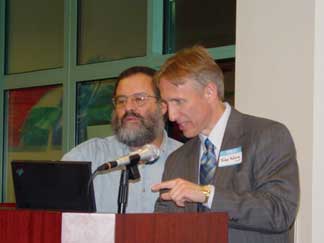 |
| Chuck Troia, Santa Clara Valley Chapter
Chair, left, assists Todd Hubing with his presentation in
November. |
 |
| Dr. Rocky Arnold spoke to the Santa
Clara Valley Chapter in October on “The Dual Challenge
of Electromagnetic Compliance and Environmental Compliance.” |
Seattle
Chapter members convened in October for an October Fest themed
meeting sponsored by Northwest EMC. There was plenty of good food
and beer for all! The speaker was Varuzhan Kocharyan of Northwest
EMC who gave a presentation titled, “An Express Diagnostic
Method for ESD Simulators and ESD Test Stations.” Dr. Kocharyan
described and demonstrated a unique and elegant method for verification
of ESD guns that could be used before every use. He showed how
such a method could verify the gun parameters as well as the two
479 KOHM bleeder resistors. Chapter members were encouraged to
bring their ESD guns for a free verification after the meeting.
It was one of the rainiest nights in recorded history in Seattle
so attendance was down, but all who braved the weather that night
were very appreciative of an excellent presentation. In November,
the Chapter was treated to the return of Franz Gisin of Sanmina-SC
in San Jose, California. The presentation was titled, “Thinking
Outside of the Trace: The Physics of High Speed PCB and Backplane
Interconnects.” Franz’s presentations always have a
high “wow” factor due to the exciting and elaborate
visuals. This presentation was no exception! Anyone who has spent
any length of time wandering around within the Signal Integrity
discipline, will, on occasion, take time out to reflect on exactly
what it is about pushing electrons around on conducting materials
that causes them to misbehave and distort signals as they are
routed through high-speed printed circuit boards and backplanes.
Franz’s presentation explored these phenomena in a riveting
and understandable way. He suggested different approaches to analyzing
high speed PCB and backplane interconnects. He also provided an
example of using sophisticated 3D computer modeling codes to directly
solve for the electric and magnetic fields in the regions surrounding
the “guiding” traces and associated ground return planes.
In December, the Chapter did not meet and instead promoted its
upcoming “Bruce Lee Show” scheduled for January 20 with
speakers Bruce Archambeault and Lee Hill. Look for coverage of
this event in the next Newsletter! It promises to be an awesome
event. As always, if you happen to be in Seattle, please check
out the website www.ieee-seattle.org
and see if a chapter meeting is scheduled during your visit. If
so, please feel free to join us!
 |
| Northwest EMC put on quite the spread
for the October Seattle EMC Chapter meeting! |
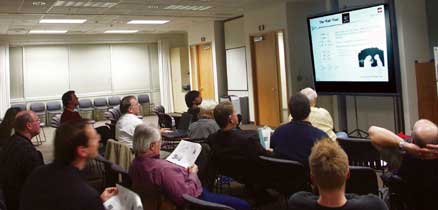 |
| A small, but intent group was present
for the Seattle EMC Chapter’s November meeting with Franz
Gisin (white shirt, middle left) as speaker. |
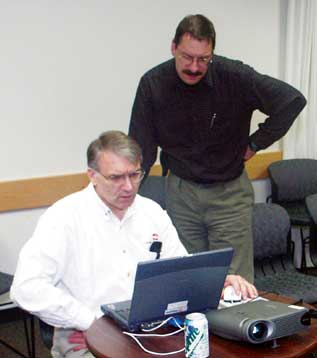 |
| Franz Gisin of Sanmina-SC (seated)
and Pat André of André Consulting get the audio-visual
working prior to Franz’s presentation to the Seattle
EMC Chapter. |
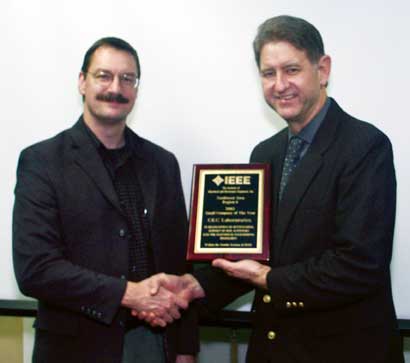 |
| Following the November meeting, Pat
André (left), Chair of the Seattle EMC Chapter, presented
Mark Chase of CKC Labs with an IEEE Seattle Section award.
The award recognized CKC Labs as “Small Company of the
Year.” |
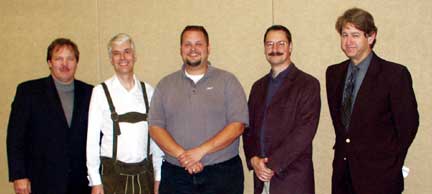 |
| It’s a line up of Seattle EMC
Chapter officers with guest Derick Skouby from HP Vancouver
(center). That’s Dean Busch, Treasurer, Stephen Stimac,
Secretary (note he got into the spirit of the October Fest
meeting theme!), Pat André, Chairman, and Mark Chase,
past Secretary and back up photographer (from left). |
 |
| Varuzhan Kockaryan of Northwest EMC
(left) enjoyed a presentation laugh with Angus McGill at the
October Seattle EMC Chapter meeting. |
Singapore
The Singapore Chapter had been largely dormant for the most part
of 2003. On March 11, 2003, the Chapter welcomed Cheung-Wei Lam
of Apple Computer in Cupertino, California to speak on the topic
of “Signal Integrity Design versus Radiated Emission Control”.
Dr. Lam is a Distinguished Lecturer of the EMCS. This meeting
was held at the Institute of High Performance Computing (IHPC)
and was well attended with 55 participants. A lull in meetings
then followed due to the outbreak of SARS in Singapore. It was
not until November that the second meeting was held with Professor
Michel S. Nakhla of Carleton University in Canada speaking on
the issue of “Recent Advances in Modeling and Simulation
of High-Speed Electronics, EMC/EMI, and Electronic Packaging”.
The November meeting was jointly organized with the CPMT (Components,
Packaging, and Manufacturing Technology Society) and IHPC. It
was well attended by 33 participants. The last meeting of 2003
was held on December 3 at the DSO National Laboratories (https://www.dso.org.sg).
Professor Christos Christopoulos, from Nottingham, U.K., spoke
on the topic of “Shielding and Coupling Inside Equipment
Cabinets.” Professor Christopoulos compared some S.E. (shielding
efficiency) results from the use of intermediate modeling tools
to those obtained from measurements. The participants had a glimpse
of some of the modeling techniques that characterize arrays of
holes and perforations as a set of DFI (digital filter interface)
parameters for TLM. After the seminar, a special general meeting
was convened amongst the EMCS members to elect officers for the
Singapore Chapter for 2004. 33 members and friends attended the
meeting in December. EMC
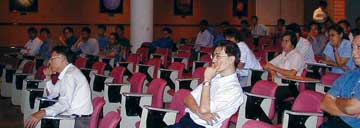 |
| Attendees listen intently during
the presentation last March in Singapore by Cheung-Wei Lam
of Apple Computer. |
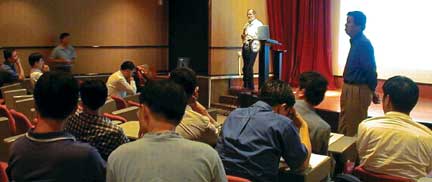 |
| At the December meeting in Singapore,
Professor Christopolos gives his presentation to a receptive
audience. Dr. See, Chairman, (right) listens to a question
from the audience. |
|
|
|
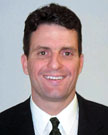 Chapter
Chatter
Chapter
Chatter 
































